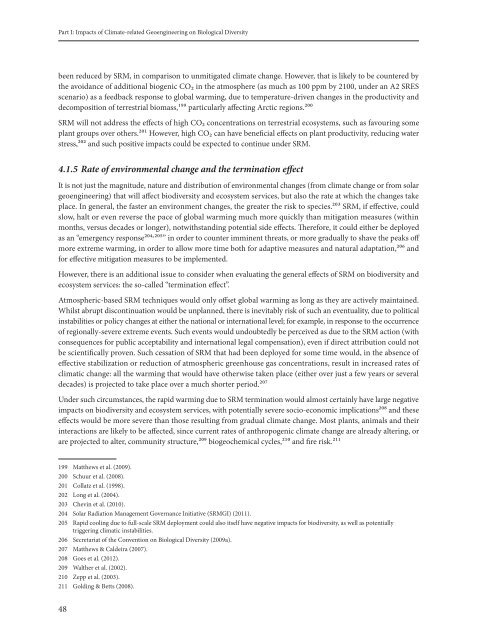cbd-ts-66-en
cbd-ts-66-en
cbd-ts-66-en
You also want an ePaper? Increase the reach of your titles
YUMPU automatically turns print PDFs into web optimized ePapers that Google loves.
Part I: Impac<strong>ts</strong> of Climate-related Geo<strong>en</strong>gineering on Biological Diversity<br />
be<strong>en</strong> reduced by SRM, in comparison to unmitigated climate change. However, that is likely to be countered by<br />
the avoidance of additional biog<strong>en</strong>ic CO2 in the atmosphere (as much as 100 ppm by 2100, under an A2 SRES<br />
sc<strong>en</strong>ario) as a feedback response to global warming, due to temperature-driv<strong>en</strong> changes in the productivity and<br />
decomposition of terrestrial biomass,199 particularly affecting Arctic regions.200<br />
SRM will not address the effec<strong>ts</strong> of high CO2 conc<strong>en</strong>trations on terrestrial ecosystems, such as favouring some<br />
plant groups over others.201 However, high CO2 can have b<strong>en</strong>eficial effec<strong>ts</strong> on plant productivity, reducing water<br />
stress,202 and such positive impac<strong>ts</strong> could be expected to continue under SRM.<br />
4.1.5 Rate of <strong>en</strong>vironm<strong>en</strong>tal change and the termination effect<br />
It is not just the magnitude, nature and distribution of <strong>en</strong>vironm<strong>en</strong>tal changes (from climate change or from solar<br />
geo<strong>en</strong>gineering) that will affect biodiversity and ecosystem services, but also the rate at which the changes take<br />
place. In g<strong>en</strong>eral, the faster an <strong>en</strong>vironm<strong>en</strong>t changes, the greater the risk to species.203 SRM, if effective, could<br />
slow, halt or ev<strong>en</strong> reverse the pace of global warming much more quickly than mitigation measures (within<br />
months, versus decades or longer), notwithstanding pot<strong>en</strong>tial side effec<strong>ts</strong>. Therefore, it could either be deployed<br />
as an “emerg<strong>en</strong>cy response204, 205” in order to counter immin<strong>en</strong>t threa<strong>ts</strong>, or more gradually to shave the peaks off<br />
more extreme warming, in order to allow more time both for adaptive measures and natural adaptation,206 and<br />
for effective mitigation measures to be implem<strong>en</strong>ted.<br />
However, there is an additional issue to consider wh<strong>en</strong> evaluating the g<strong>en</strong>eral effec<strong>ts</strong> of SRM on biodiversity and<br />
ecosystem services: the so-called “termination effect”.<br />
Atmospheric-based SRM techniques would only offset global warming as long as they are actively maintained.<br />
Whilst abrupt discontinuation would be unplanned, there is inevitably risk of such an ev<strong>en</strong>tuality, due to political<br />
instabilities or policy changes at either the national or international level; for example, in response to the occurr<strong>en</strong>ce<br />
of regionally-severe extreme ev<strong>en</strong><strong>ts</strong>. Such ev<strong>en</strong><strong>ts</strong> would undoubtedly be perceived as due to the SRM action (with<br />
consequ<strong>en</strong>ces for public acceptability and international legal comp<strong>en</strong>sation), ev<strong>en</strong> if direct attribution could not<br />
be sci<strong>en</strong>tifically prov<strong>en</strong>. Such cessation of SRM that had be<strong>en</strong> deployed for some time would, in the abs<strong>en</strong>ce of<br />
effective stabilization or reduction of atmospheric gre<strong>en</strong>house gas conc<strong>en</strong>trations, result in increased rates of<br />
climatic change: all the warming that would have otherwise tak<strong>en</strong> place (either over just a few years or several<br />
decades) is projected to take place over a much shorter period.207<br />
Under such circumstances, the rapid warming due to SRM termination would almost certainly have large negative<br />
impac<strong>ts</strong> on biodiversity and ecosystem services, with pot<strong>en</strong>tially severe socio-economic implications208 and these<br />
effec<strong>ts</strong> would be more severe than those resulting from gradual climate change. Most plan<strong>ts</strong>, animals and their<br />
interactions are likely to be affected, since curr<strong>en</strong>t rates of anthropog<strong>en</strong>ic climate change are already altering, or<br />
are projected to alter, community structure,209 biogeochemical cycles,210 and fire risk.211<br />
199 Matthews et al. (2009).<br />
200 Schuur et al. (2008).<br />
201 Collatz et al. (1998).<br />
202 Long et al. (2004).<br />
203 Chevin et al. (2010).<br />
204 Solar Radiation Managem<strong>en</strong>t Governance Initiative (SRMGI) (2011).<br />
205 Rapid cooling due to full-scale SRM deploym<strong>en</strong>t could also i<strong>ts</strong>elf have negative impac<strong>ts</strong> for biodiversity, as well as pot<strong>en</strong>tially<br />
triggering climatic instabilities.<br />
206 Secretariat of the Conv<strong>en</strong>tion on Biological Diversity (2009a).<br />
207 Matthews & Caldeira (2007).<br />
208 Goes et al. (2012).<br />
209 Walther et al. (2002).<br />
210 Zepp et al. (2003).<br />
211 Golding & Bet<strong>ts</strong> (2008).<br />
48


